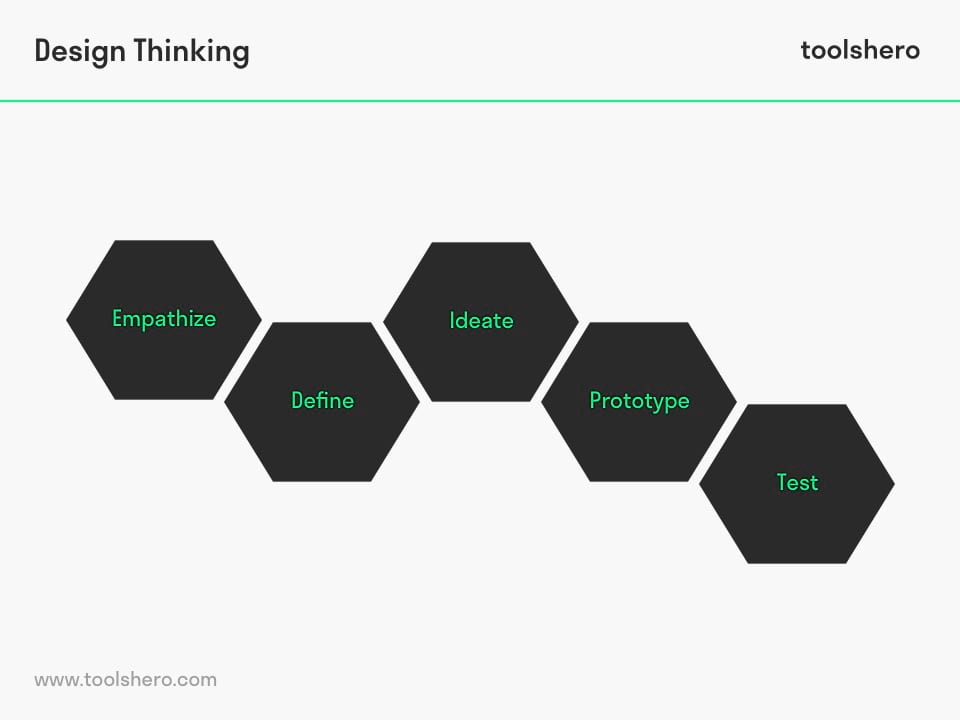Design Thinking Process by Herbert Simon

Design Thinking: this article describes the concept of Design Thinking, developed by Herbert Simon in a practical way. In addition to what this method is, this article also explains the importance of customer need, its origin, the five steps to get started with this method (including a Design Thinking example) and the fact that this approach is not linear. After reading you will understand the basics of this problem solving and creativity method. Enjoy reading!
What is Design Thinking?
Nowadays, innovation is playing an increasingly important role in business and society as a whole. That requires a constant flow of new ideas, something that Design Thinking can help with.
Design Thinking can be defined as a method of problem solving that can achieve extraordinary, creative results. It’s a people-focused, instinctive approach to renew and innovate based on technology, customer needs, customer wants and more.
Design Thinking doesn’t have a fixed protocol; it’s a different way of thinking.
First, the problem is defined. Then you look for solutions that include the wants and needs of the customer / end-user. That method gives existing forms new meaning.
Design Thinking and customer needs
Design Thinking ignores existing data and evidence. The thing that matters is whether it meets the customer’s needs. That way, it can transform a viable business strategy into customer value and market opportunities.
Design Thinking changes the way organisations develop products, services, processes and strategies. It allows people who aren’t trained designers, to creatively approach challenges.
It’s a convenient way to take on complex issues that are poorly defined or unknown. By understanding people’s needs, by redefining the problem and by generating a lot of ideas in brainstorming sessions, Design Thinking steps away from the scientific feedback mechanism.
Herbert Simon, founder of Design Thinking
Herbert Simon was the American psychologist and sociologist who, in his 1969 article Sciences of the artificial, described the word ‘design’ as the ‘changing existing circumstances into preferred ones’.
Together with other scientists he laid the foundation for design thinking.
Design Thinking is always linked to improving the future. It’s a creative process, based on building ideas.
There’s no judgement in Design Thinking, as that would get in the way of maximum input. Even the craziest ideas are welcomed because they can often lead to the most creative solutions. Everyone is a designer and can apply Design Thinking to all of life’s situations.
Herbert Simon describes various basic steps that can be helpful for Design Thinking.
It starts with defining the problems. Next, research takes place based on questions (who, what, why, where, when). Then come possible ideas that might lead to a solution.
After trying some of these ideas (prototypes), the best one is chosen. That idea is implemented and finally evaluated. If it turns out that the solution has failed, it’s been a learning experience. The steps are non linear and can occur simultaneously and be repeated.
Key elements of Design Thinking
Over the years, many variants of Design Thinking have emerged. However, all are based on the principles Herbert Simon set forth in his 1969 article.
They’ve been reduced to five key elements below. These elements can serve as a foundation for design thinking:

Figure 1 – Steps of Design Thinking (Simon)
1. Empathize
Begin to understand what the human needs of all concerned are, including customers, clients and employees. It sounds simple, but this is the most critical phase. The goal of this phase is to solve the correct problem, and then to solve the problem in a way that leads to creative solutions.
By first creating an empathic understanding of the problem, design thinkers are encouraged to set aside their own preconceptions to get more insight into the customers’ and users’ wants and needs.
All data gathered from the wants and needs of the users can help put the problem into words. That means that finding this out requires a lot of field research.
2. Define
After the empathetic phase, a company that has been producing coffee machines for years comes to the understanding that the sales have stagnated. They can decide to produce more types of coffee machines and offer those to their customers.
By putting themselves in the shoes of their users, and once again ignoring their own preconceptions, they can discover that about 80% of them want a small machine that can brew 1 or 2 cups of strong coffee at a time, similar to espresso.
According to Design Thinking the formulation of the problem can now be defined as’: “80% of the users want a small and functional device that can brew 1 or 2 cups of strong coffee at a time”.
Design Thinking Tool Box | 50+ Methods | 25+ Templates
3. Ideate
Encourage creativity by generating as many ideas as possible. Brainstorming sessions with the own team can be very useful for this. Even obvious or rehashed ideas are allowed during this phase.
Design Thinking requires considering as many ideas as possible, in order to approach the problem from different angles. That leads to the best results.
The coffee machine company’s designers are ready to generate as many ideas as they can. They’re able to understand the wants and needs of the end-users, as discussed in the first phase. It’s about the quantity of ideas, not the quality.
4. Prototype
Design Thinking offers every idea a fair chance and considers its advantages and disadvantages.
Even ideas that don’t seem all that great and effective at first are carefully examined. The most promising results are embraced and cherished. It’s about a small number of ideas that have high likelihood of success.
At this stage, many options will need to be combined and smaller ideas will be merged an integrated. Subsequently a small number of cheap versions of the product are manufactured, in the form of prototypes.
The coffee machine company has developed a number of versions of small coffee-espresso machines, ready to be tested by a user panel.
5. Test
The prototypes are shared with and tested by the team, any other relevant departments and by the users. This experimental phase is about identifying the best possible solution. The prototypes are repeatedly evaluated and improved based on user experiences.
At the end of this stage the design team will have a clearer idea of the product’s inherent limitations, problems present and a better / more informed perspective on how users would act, think and feel when they use the end-product.
If the outcome is satisfactory, the coffee machine producer can start selling the new device and use marketing to promote the message that the product was developed with the help of the people who were going to use it. This human story inspires and shows that the company is willing and able to find solutions with the help of the users’ insights.
Design Thinking: non linear
There are many methods available for Design Thinking, including interviews, reviews, user profiles, prototypes, mind mapping, questionnaires, and situational analyses.
The phases and steps of Design Thinking don’t have to be carried out in a particular order and can be done in parallel and repeated as necessary. In practice, the process is very flexible and non linear.
More than one phase can be carried out simultaneously by different groups in the design team. The designers can also collect information and create prototypes to bring their ideas to live and try to visualise solutions.
Moreover, results from the testing phase can reveal a number of insights from users, which can then lead to new brainstorming sessions or the development of new prototypes. Design Thinking describes a repeatable process that uses unique and creative techniques that are guaranteed to lead to results.
It’s Your Turn
What do you think? What is your experience with Design Thinking within your organization? Do you recognize the practical explanation or do you have more additions? What are your success factors for good idea generation and the renew of products, services or other?
Share your experience and knowledge in the comments box below.
More information
- Dorst, K. (2011). The core of ‘design thinking’ and its application. Design studies, 32(6), 521-532.
- Martin, R. L. (2009). The design of business: Why design thinking is the next competitive advantage. Harvard Business Press.
- Rowe, P. G. (1991). Design thinking. MIT press.
- Simon, H. A. (1996). The sciences of the artificial. MIT press.
How to cite this article:
Mulder, P. (2017). Design Thinking Process (Simon). Retrieved [insert date] from Toolshero: https://www.toolshero.com/creativity/design-thinking/
Original publication date: 27/08/2017 | Last update: 12/27/2023
Add a link to this page on your website:
<a href=”https://www.toolshero.com/creativity/design-thinking/”>Toolshero: Design Thinking Process (Simon)</a>













One response to “Design Thinking Process by Herbert Simon”
Hey Patty, Valuable resource indeed! Thanks for sharing. I will try to keep in mind the design thinking of yours. Thank you